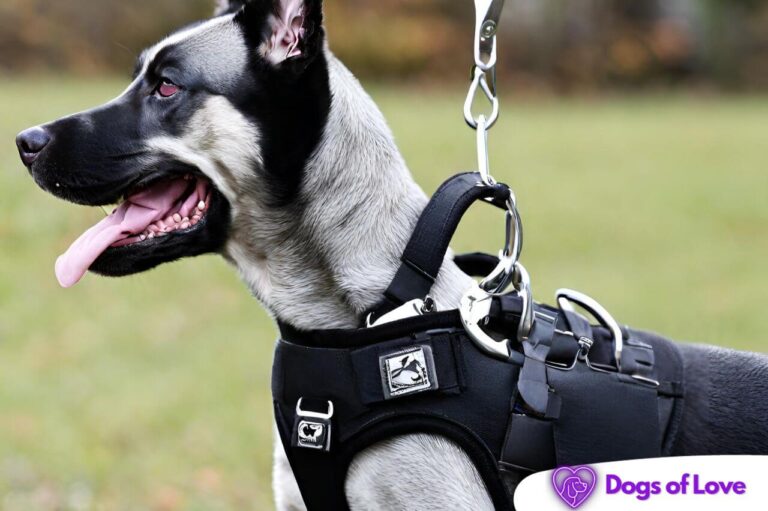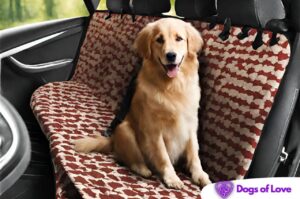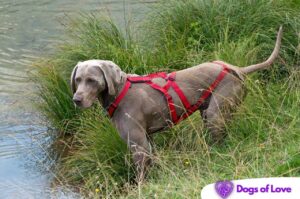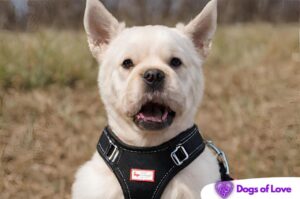When choosing a dog harness, one of the critical factors to consider is how well it accommodates your dog’s natural movements.
A well-designed harness should not restrict the dog’s shoulder movement, allowing them to walk, run, and play comfortably.
Shoulder movement is essential for dogs to maintain balance, flexibility, and overall mobility.
In this exploration, we will explore the various harnesses and features that prioritize your dog’s shoulder mobility, ensuring they can move freely and happily during walks and activities while remaining secure and controlled.

What are the Benefits of an Unrestrictive Dog Harness?
The benefits of an unrestrictive dog harness are numerous and significant.
These harnesses prioritize a dog’s natural shoulder movement, ensuring they can walk, run, and play without discomfort or limitations.
When a dog’s shoulders are free to move as intended, it helps maintain their natural gait and posture, reducing the risk of strain or injury during physical activities.
Unrestrictive harnesses are particularly valuable for active dogs, as they allow for better agility, enabling them to enjoy a higher level of physical activity and engagement.
This not only supports their physical health but also their mental well-being, as they can explore and interact with their environment more freely.
Additionally, for dogs prone to pulling, unrestrictive harnesses can provide better control while keeping their shoulders free from any undue pressure, ensuring that both the pet owner and the dog have a more enjoyable and harmonious walking experience.
What are the Types of Unrestrictive Harnesses?
When it comes to unrestrictive dog harnesses, there are various types to choose from, each designed to ensure a dog’s natural shoulder movement remains unencumbered.
One typical design is the Y-shaped harness, which gently encircles the dog’s neck and extends beneath the chest.
This configuration avoids putting pressure on the sensitive shoulder area, allowing for a full range of motion during walks and physical activities.
Another type includes step-in harnesses, which involve a straightforward design where the dog steps into the harness and fastens securely around their back.
Vest harnesses, with a comfortable and snug fit, also offer unrestrictive support by evenly distributing the weight across the chest and shoulders.
No-pull harnesses, such as front-clip or head-halters, are specialized options that prioritize an unrestrictive experience for dogs prone to pulling, discouraging undue pressure on the shoulders.
These various types of unrestrictive harnesses ensure your dog can move freely, comfortably, and safely during daily activities.
How can you Choose the Right Size Harness for Your Dog?
Selecting the right size harness for your dog is essential to ensure a comfortable and safe fit.
First, measure your dog’s girth, the widest part of their chest, just behind the front legs.
Consult the manufacturer’s sizing guide for the specific harness you’ve chosen, and select the size that corresponds to your dog’s measurements.
The harness mustn’t be too tight, as this can cause discomfort or chafing, but it also shouldn’t be too loose, as it may lead to escape or ineffective control.
Once you’ve chosen the correct size, adjust the harness straps to fit snugly, but allow a couple of fingers to fit between the harness and your dog’s skin.
Always check for any rubbing, redness, or signs of discomfort during the initial uses, and make necessary adjustments to ensure a secure and comfortable fit for your four-legged friend.
How to Properly Put on and Remove a Dog Harness?
Properly putting on and removing a dog harness is essential to ensure your dog’s comfort and safety.
To put on the harness, lay it flat on the ground and have your dog step into it, ensuring the D-ring for leash attachment is on their back.
Lift the harness and secure the buckles, ensuring a tight fit.
The straps should lie flat against your dog’s chest and back without twisting. Always check for the proper alignment and adjust if needed.
To remove the harness, release the buckles and gently slide it off your dog’s forelimbs, being careful not to pull or yank.
This process should be smooth and stress-free for your dog to maintain a positive association with the harness.
Properly putting on and removing the harness ensures that your dog remains comfortable and safe during walks and activities, fostering an enjoyable experience for both you and your furry companion.
What are the Common Mistakes to Avoid When Using a Dog Harness?
When using a dog harness, several common mistakes should be avoided to ensure your dog’s comfort and safety.
One frequent error is choosing the wrong size or style of harness, which can lead to discomfort, chafing, or ineffective control.
Ensure the harness fits properly and corresponds to your dog’s needs.
Another mistake is not adjusting the harness correctly; straps that are too loose or too tight can cause discomfort or even injury.
Improper attachment of the leash to the harness is another standard error, potentially causing strain on the dog’s neck or allowing them to escape.
Always use the designated D-ring on the back of the harness for leash attachment.
Jerking or pulling too hard on the leash is also something to avoid, as it can cause discomfort and stress to your dog.
Finally, neglecting regular checks and harness maintenance is a mistake, as damaged or worn-out harnesses can compromise your dog’s safety and well-being.
By avoiding these common errors, you can ensure a positive and safe harness-wearing experience for your furry companion.
In conclusion
Selecting a dog harness that does not restrict the dog’s shoulder movement is paramount for ensuring your canine companion’s comfort, mobility, and overall well-being.
Harnesses designed with an unrestrictive approach, such as those with Y-shaped configurations, step-in, vest, or no-pull harnesses, allow your dog to move freely while maintaining control during walks and activities.
The benefits of unrestrictive harnesses are numerous, promoting agility, reducing the risk of injury, and fostering an enjoyable and harmonious experience for you and your four-legged friend.
By choosing the correct harness and considering your dog’s specific needs, you can support their natural movements, creating a positive and safe environment for countless adventures together.








